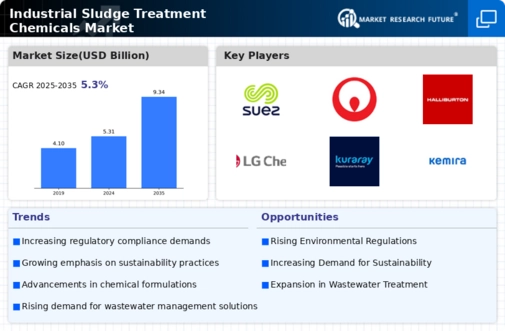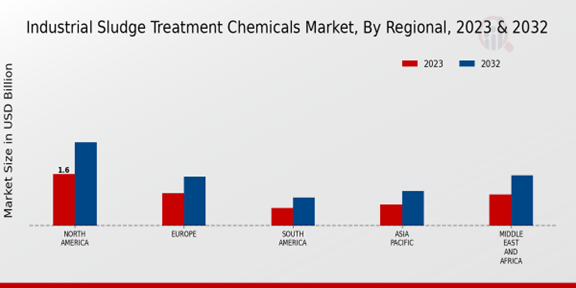Rising Industrialization
Rapid industrialization across various regions is a significant driver for the Global Industrial Sludge Treatment Chemicals Market Industry. As industries expand, the volume of sludge generated increases, necessitating efficient treatment solutions. Countries in Asia-Pacific, particularly China and India, are witnessing unprecedented industrial growth, leading to higher sludge production. This trend creates a substantial demand for treatment chemicals that can effectively manage industrial waste. The market is expected to grow at a CAGR of 5.27% from 2025 to 2035, indicating a robust response to the challenges posed by industrial waste management.
Market Growth Projections
Technological Advancements
Innovations in sludge treatment technologies are transforming the Global Industrial Sludge Treatment Chemicals Market Industry. The development of advanced chemical formulations and treatment processes enhances the efficiency of sludge management. For example, the introduction of bio-based treatment chemicals offers environmentally friendly alternatives to traditional methods. These advancements not only improve treatment efficacy but also reduce operational costs for industries. As the market evolves, the adoption of such technologies is likely to drive growth, contributing to an anticipated market size of 9.34 USD Billion by 2035.
Growing Environmental Regulations
The Global Industrial Sludge Treatment Chemicals Market Industry is experiencing a surge in demand due to increasing environmental regulations. Governments worldwide are implementing stringent policies aimed at reducing pollution and promoting sustainable waste management practices. For instance, the European Union has established directives that mandate proper sludge treatment and disposal methods. This regulatory landscape compels industries to adopt advanced sludge treatment chemicals to comply with legal requirements. As a result, the market is projected to reach 5.31 USD Billion in 2024, reflecting the urgency for effective treatment solutions that align with environmental standards.
Expansion of Water Treatment Facilities
The expansion of water treatment facilities globally is a crucial driver for the Global Industrial Sludge Treatment Chemicals Market Industry. As urban populations grow, the demand for clean water increases, prompting governments and private entities to invest in water treatment infrastructure. This expansion generates substantial amounts of sludge, necessitating effective treatment chemicals to manage the byproducts. The market's growth is closely tied to these developments, as the need for efficient sludge management solutions becomes more pronounced in the context of expanding water treatment capabilities.
Increased Awareness of Waste Management
There is a growing awareness regarding the importance of effective waste management practices, which significantly influences the Global Industrial Sludge Treatment Chemicals Market Industry. Stakeholders, including industries and consumers, are increasingly recognizing the environmental and health impacts of improper sludge disposal. This heightened awareness encourages industries to invest in better treatment solutions, thereby driving demand for sludge treatment chemicals. As companies strive to enhance their sustainability profiles, the market is poised for growth, aligning with global efforts to promote responsible waste management.






















